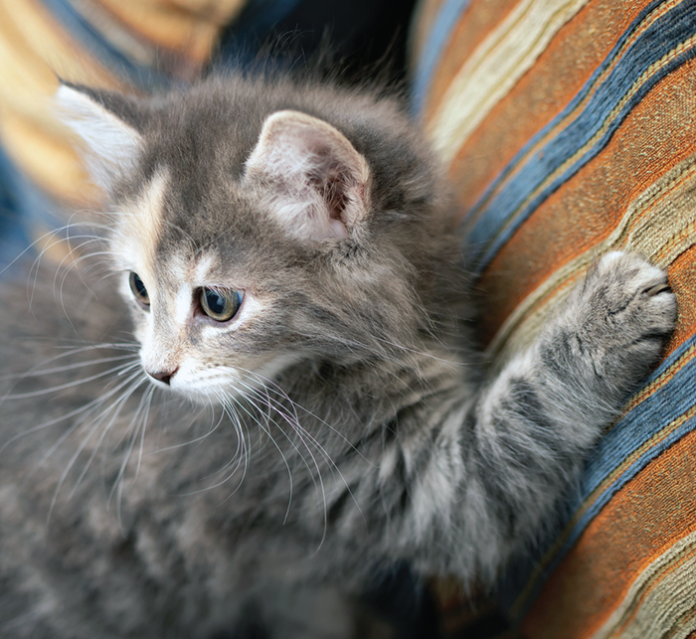Scratching furniture and curtains is a feline trait that has frustrated cat owners for many years. Luckily for you, behaviorists, veterinarians, and owners have been studying this challenge for a long time, and we have some insight and tips for you.
Why She Scratches
The Cornell Feline Health Center says that scratching is largely a marking behavior that deposits scent from special glands on the cat’s paws into his territory and removes the translucent covering, or sheath, from the claws. We can’t smell the pheromones from the glands on your cat’s front paws, but your cat (and other cats) can. Scratching is something your cat does naturally and is likely to try out even if you don’t have other cats in the house.
Because scratching is an innate behavior, it can be difficult to stop. Redirecting your cat’s scratching to an acceptable scratching post (more on that later!) is a better approach.
The good news is, cats who scratch a lot will often wear their nails down on their own and need less frequent nail trims than cats who rarely scratch.
Proper Outlet
Since getting your cat to completely stop scratching is a battle that can be difficult to win, provide her with an alternative item to scratch. Before going out and buying a fancy scratching post, consider your cat’s scratching tendencies and preferences. Does she go after the couch and arm chairs, which are vertical surfaces with fabric, or does she prefer trying to rip up the carpet? Does she tug at the curtains or go for door frames? Once you know what your cat likes, you can choose a scratching post or scratch board that fits her orientation and material preferences so she will be more likely to use it.
Once you have picked out (or built) a scratching post for your cat, set it up either next to or blocking the items that you don’t want her to scratch. You may be able to move the scratching post later, but for now, take advantage of the fact that she already associates that location with scratching and use it to transition her over to the post.
You can encourage your cat to use the post by rubbing catnip on it to attract her or by dragging a toy up or across it. If she starts to approach the off-limits furniture, gently pick her up and move her to the scratching post. During this learning period it is usually best to limit your cat’s access to the room/items that she likes to scratch so that you can interrupt any poor choices and consistently redirect her to the scratching post.
You may need multiple scratching posts or boards if your cat has multiple locations that she likes to scratch.
Breaking the Cycle
Scratching is a rewarding behavior for your cat—she has thousands of years of evolution telling her to do it, it’s good exercise, and it marks her territory as her own. As well as providing items that she is allowed to scratch, you will need to make the furniture, curtains, carpeting, and walls less attractive to her.
Start by washing the areas (if possible) she has been scratching to remove the scent of her pheromones. You can try a cat repellent spray, but be sure it won’t stain the item you are spraying. Place her new scratching post or board near her favorite scratching place (even blocking it), and rub catnip on that so it smells more appealing than the furniture.
Covering your furniture may make it less satisfying to scratch. Try sheets of plastic, smooth plastic shields or covers, aluminum foil, or double sided tape.
Another option is to “booby trap” the area you want your cat to leave alone with something that will startle her but not hurt her. Katherine Houpt, VMD, PhD, DACVB, Emeritus Cornell Professor of Behavior Medicine, often recommends a tower of plastic cups that will fall when your cat brushes up against it. A compressed air canister or noisemaker that is hooked up to a motion-sensor also may work.
All of these options don’t require human presence, so they will work to protect your furniture even when you are not around. This is much more successful than scolding your cat or using a squirt bottle (these are not recommended methods!), as cats quickly learn that they can get away with scratching when you aren’t around.
Never yell at your cat or punish her physically for scratching. She is unlikely to understand that the scratching is the issue, and instead it may cause her to fear you or lash out and attack you. Plus, these deterrents depend on you being in the room, so she will still scratch when you are elsewhere, which makes it even more difficult for her to learn that scratching the furniture is the problem behavior.
If you are unable to set up a shield of some sort for the area your cat scratches, prevent her from accessing it by keeping her in another room when you are out or placing her in a large dog crate along with water and a litterbox. This will allow you to work on training when you are home and prevent setbacks when you are away.
Getting Creative
If commercial scratching posts and boards are too expensive or don’t look like they will strike your cat’s fancy, try making your own! Your scratching station should be sturdy enough to withstand the force of your cat leaning and scratching and oriented at the angle she prefers (vertical or horizontal) and covered in a material or materials she likes to scratch. Remember: If it falls down when she tries to scratch or otherwise scares or harms her, she will not use it.
Some options for materials include:
- Sisal
- Carpet samples
- Indoor-outdoor carpeting
- Cardboard
- Wood, with or without bark
If you have multiple cats, you may need multiple scratching stations to fit each cat’s preferences.




